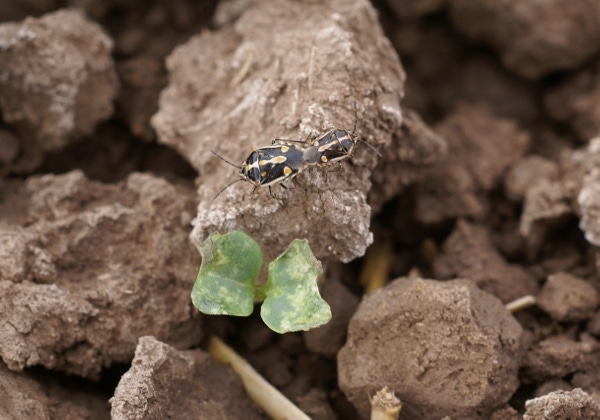
2010-2015: Impact of bagrada bug on desert cole crops
PCAs have adopted effective management programs to protect seedling crops from the bagrada bug during stand establishment. Insecticide usage to control this pest remains high, and the percentage of acreage treated in 2015 was consistent with previous years.
June 1, 2016

With the 2015-2016 winter produce season finally finished, now is a good time to reflect on pest issues last fall.
The bagrada bug, Bagrada hilaris, first occurred on desert cole crops at damaging levels in Fall 2010 and has since been an established pest.
In an attempt to document the severity of bagrada bug infestations on direct seeded and transplanted cole crops, and the intensity of chemical management, we have annually surveyed growers and pest control advisers from Yuma, Imperial, and Maricopa counties since 2010.
We recently conducted our annual survey in April.
Since 2010, the cole crop industry has experienced widespread bagrada bug infestations throughout the desert from September into November, although some years have been less intense than others.
Last fall was the lightest year we’ve seen to date. Based on seasonal population abundance studies of adults infesting non-treated broccoli plants at the Yuma Agricultural Center, bagrada bug infestations were lower than what we had observed since the pest first showed up in the desert.
Estimates of stand losses from bagrada bug infestations at stand establishment in both direct seeded and transplanted crops have decreased by more than 50 percent over the last five years. The lower losses reported last fall were likely due to the lighter bagrada pressure experienced last season.
Plant injury, defined as plants with multiple heads, forked terminals, and/or blind terminals resulting from bagrada feeding, was also lower in 2015 compared to previous years.
These data suggest that PCAs have adopted effective management programs to protect seedling crops during stand establishment. Insecticide usage to control this pest remains high, and the percentage of acreage treated in 2015 was consistent with previous years.
Pyrethroids remain the primary product used to control bagrada bug adults either via chemigation or with foliar spray applications. Based on survey results, products that have contact activity appeared to provide the most effective control against bagrada adults on both direct seeded and transplanted cole crops.
However, more neonicotinoid products (Venom) are beginning to be implemented into PCA’s IPM programs.
Overall, the results of the PCA survey are consistent with results obtained in research trials conducted at the Yuma Agricultural Center over the past four years.
A summary of the 2010-2015 survey results can be found in this report - Impact of Bagrada Bug on Desert Cole Crops, 2010-2015.
Note: This article is from the May 25, 2016 issue of the University of Arizona’s “Vegetable IPM Updates’ e-newsletter and is reprinted with permission from Dr. Palumbo.
Latest news in western agriculture – Western Farm Press Daily e-news blast - delivered free to your inbox.
You May Also Like



